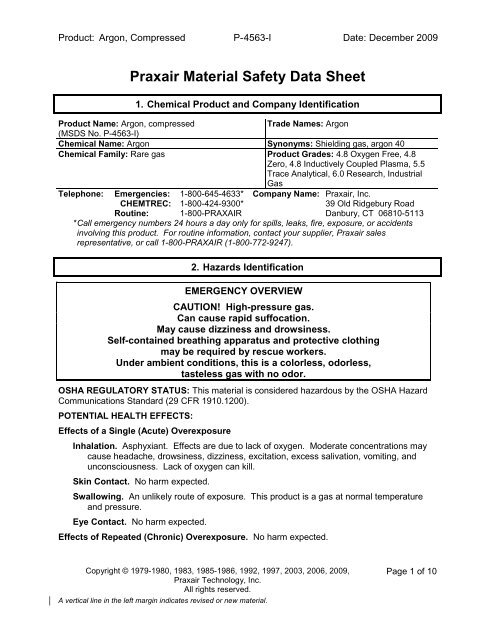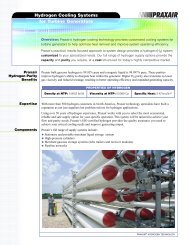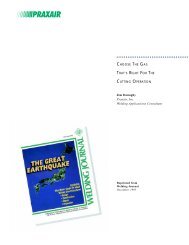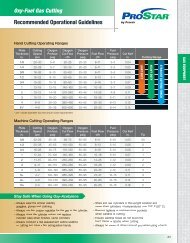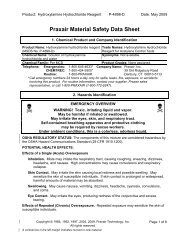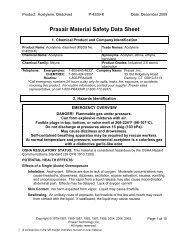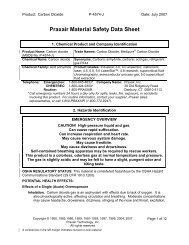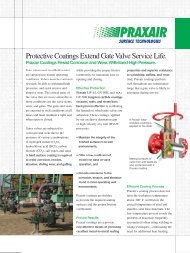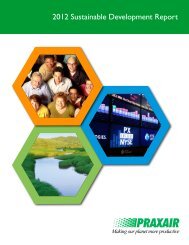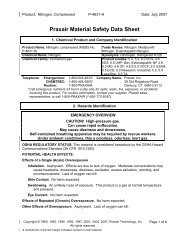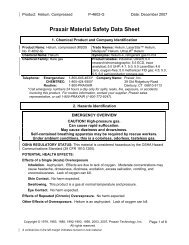Argon, Compressed Gas, Material Safety Data Sheet ... - Praxair
Argon, Compressed Gas, Material Safety Data Sheet ... - Praxair
Argon, Compressed Gas, Material Safety Data Sheet ... - Praxair
You also want an ePaper? Increase the reach of your titles
YUMPU automatically turns print PDFs into web optimized ePapers that Google loves.
Product: <strong>Argon</strong>, <strong>Compressed</strong> P- 4563-I Date: December 2009<br />
<strong>Praxair</strong> <strong>Material</strong> <strong>Safety</strong> <strong>Data</strong> <strong>Sheet</strong><br />
1. Chemical Product and Company Identification<br />
Product Name: <strong>Argon</strong>, compressed<br />
(MSDS No. P-4563-I)<br />
Trade Names: <strong>Argon</strong><br />
Chemical Name: <strong>Argon</strong> Synonyms: Shielding gas, argon 40<br />
Chemical Family: Rare gas Product Grades: 4.8 Oxygen Free, 4.8<br />
Zero, 4.8 Inductively Coupled Plasma, 5.5<br />
Trace Analytical, 6.0 Research, Industrial<br />
<strong>Gas</strong><br />
Telephone: Emergencies: 1-800-645-4633* Company Name: <strong>Praxair</strong>, Inc.<br />
CHEMTREC: 1-800-424-9300* 39 Old Ridgebury Road<br />
Routine: 1-800-PRAXAIR Danbury, CT 06810-5113<br />
* Call emergency numbers 24 hours a day only for spills, leaks, fire, exposure, or accidents<br />
involving this product. For routine information, contact your supplier, <strong>Praxair</strong> sales<br />
representative, or call 1-800-PRAXAIR (1-800-772-9247).<br />
2. Hazards Identification<br />
EMERGENCY OVERVIEW<br />
CAUTION! High-pressure gas.<br />
Can cause rapid suffocation.<br />
May cause dizziness and drowsiness.<br />
Self-contained breathing apparatus and protective clothing<br />
may be required by rescue workers.<br />
Under ambient conditions, this is a colorless, odorless,<br />
tasteless gas with no odor.<br />
OSHA REGULATORY STATUS: This material is considered hazardous by the OSHA Hazard<br />
Communications Standard (29 CFR 1910.1200).<br />
POTENTIAL HEALTH EFFECTS:<br />
Effects of a Single (Acute) Overexposure<br />
Inhalation. Asphyxiant. Effects are due to lack of oxygen. Moderate concentrations may<br />
cause headache, drowsiness, dizziness, excitation, excess salivation, vomiting, and<br />
unconsciousness. Lack of oxygen can kill.<br />
Skin Contact. No harm expected.<br />
Swallowing. An unlikely route of exposure. This product is a gas at normal temperature<br />
and pressure.<br />
Eye Contact. No harm expected.<br />
Effects of Repeated (Chronic) Overexposure. No harm expected.<br />
Copyright © 1979-1980, 1983, 1985-1986, 1992, 1997, 2003, 2006, 2009,<br />
<strong>Praxair</strong> Technology, Inc.<br />
All rights reserved.<br />
A vertical line in the left margin indicates revised or new material.<br />
Page 1 of 10
Product: <strong>Argon</strong>, <strong>Compressed</strong> P- 4563-I Date: December 2009<br />
Other Effects of Overexposure. <strong>Argon</strong> is an asphyxiant. Lack of oxygen can kill.<br />
Medical Conditions Aggravated by Overexposure. The toxicology and the physical and<br />
chemical properties of argon suggest that overexposure is unlikely to aggravate existing medical<br />
conditions.<br />
CARCINOGENICITY: <strong>Argon</strong> is not listed by NTP, OSHA, or IARC.<br />
POTENTIAL ENVIRONMENTAL EFFECTS: None known. For further information, see section<br />
12, Ecological Information.<br />
3. Composition/Information on Ingredients<br />
See section 16 for important information about mixtures.<br />
COMPONENT CAS NUMBER CONCENTRATION<br />
<strong>Argon</strong> 7440-37-1 >99%*<br />
*The symbol > means “greater than.”<br />
4. First Aid Measures<br />
INHALATION: Immediately remove to fresh air. If not breathing, give artificial respiration. If<br />
breathing is difficult, qualified personnel may give oxygen. Call a physician.<br />
SKIN CONTACT: Flush with water. If discomfort persists, seek medical attention.<br />
SWALLOWING: An unlikely route of exposure. This product is a gas at normal temperature<br />
and pressure.<br />
EYE CONTACT: Flush eyes thoroughly with warm water. Hold the eyelids open and away from<br />
the eyeballs to ensure that all surfaces are thoroughly flushed. If discomfort persists, seek<br />
medical attention.<br />
NOTES TO PHYSICIAN: There is no specific antidote. Treatment of overexposure should be<br />
directed at the control of symptoms and the clinical condition of the patient. Refer to section 16.<br />
5. Fire Fighting Measures<br />
FLAMMABLE PROPERTIES: Nonflammable<br />
SUITABLE EXTINGUISHING MEDIA: <strong>Argon</strong> cannot catch fire. Use media appropriate for<br />
surrounding fire.<br />
PRODUCTS OF COMBUSTION: Not applicable.<br />
PROTECTION OF FIREFIGHTERS: CAUTION! High-pressure gas. Evacuate all personnel<br />
from danger area. Immediately deluge cylinders with water from maximum distance until cool;<br />
then move them away from fire area if without risk. Self-contained breathing apparatus may be<br />
required by rescue workers. (See section 16.) On-site fire brigades must comply with OSHA 29<br />
CFR 1910.156.<br />
Specific Physical and Chemical Hazards. Heat of fire can build pressure in cylinder and<br />
cause it to rupture. No part of cylinder should be subjected to a temperature higher than 125°F<br />
(52°C). <strong>Argon</strong> cylinders are equipped with a pressure relief device. (Exceptions may exist<br />
where authorized by DOT.)<br />
Page 2 of 10
Product: <strong>Argon</strong>, <strong>Compressed</strong> P- 4563-I Date: December 2009<br />
Protective Equipment and Precautions for Firefighters. Firefighters should wear personal<br />
protective equipment and fire-fighting turnout gear as appropriate for surrounding fire.<br />
6. Accidental Release Measures<br />
STEPS TO BE TAKEN IF MATERIAL IS RELEASED OR SPILLED:<br />
CAUTION! High-Pressure <strong>Gas</strong>.<br />
Personal Precautions. <strong>Argon</strong> is an asphyxiant. Lack of oxygen can kill. Evacuate all<br />
personnel from danger area. Use self-contained breathing apparatus where needed. Shut off<br />
leak if without risk. Ventilate area of leak or move cylinder to a well-ventilated area. Test for<br />
sufficient oxygen, especially in confined spaces, before allowing reentry.<br />
Environmental Precautions. Keep personnel away. Discard any product, residue, disposable<br />
container, or liner in an environmentally acceptable manner, in full compliance with federal,<br />
state, and local regulations. If necessary, call your local supplier for assistance.<br />
7. Handling and Storage<br />
PRECAUTIONS TO BE TAKEN IN HANDLING: Protect cylinders from damage. Use a suitable<br />
hand truck to move cylinders; do not drag, roll, slide, or drop. Never attempt to lift a cylinder by<br />
its cap; the cap is intended solely to protect the valve. Never insert an object (e.g., wrench,<br />
screwdriver, pry bar) into cap openings; doing so may damage the valve and cause a leak. Use<br />
an adjustable strap wrench to remove over-tight or rusted caps. Slowly open valve.. If valve is<br />
hard to open, discontinue use and contact your supplier. Close valve after each use; keep<br />
closed even when empty. Never apply flame or localized heat directly to any part of the<br />
cylinder. High temperatures may damage the cylinder and could cause the pressure relief<br />
device to fail prematurely, venting the cylinder contents. For other precautions in using this<br />
mixture, see section 16.<br />
PRECAUTIONS TO BE TAKEN IN STORAGE: Store and use with adequate ventilation. Firmly<br />
secure cylinders upright to keep them from falling or being knocked over. Screw valve<br />
protection cap firmly in place by hand. Store only where temperature will not exceed 125°F<br />
(52°C). Store full and empty cylinders separately. Use a first-in, first-out inventory system to<br />
prevent storing full cylinders for long periods.<br />
RECOMMENDED PUBLICATIONS: For further information on storage, handling, and use, see<br />
<strong>Praxair</strong> publication P-14-153, Guidelines for Handling <strong>Gas</strong> Cylinders and Containers. Obtain<br />
from your local supplier.<br />
8. Exposure Controls/Personal Protection<br />
See section 16 for important information on by-products generated during use<br />
in welding and cutting.<br />
COMPONENT OSHA PEL ACGIH TLV-TWA (2009)<br />
<strong>Argon</strong><br />
IDLH = Not available.<br />
Not Established. Simple asphyxiant<br />
Page 3 of 10
Product: <strong>Argon</strong>, <strong>Compressed</strong> P- 4563-I Date: December 2009<br />
ENGINEERING CONTROLS:<br />
Local Exhaust. Use a local exhaust system, if necessary, to prevent oxygen deficiency and<br />
keep hazardous fumes and gases below applicable exposure limits in the worker’s breathing<br />
zone.<br />
Mechanical (General). General exhaust ventilation may be acceptable if it can maintain an<br />
adequate supply of air and keep hazardous fumes and gases below applicable TLVs in the<br />
worker’s breathing zone.<br />
Special. None<br />
Other. None<br />
PERSONAL PROTECTIVE EQUIPMENT:<br />
Skin Protection. Wear work gloves when handling cylinders; welding gloves for welding.<br />
Metatarsal shoes for cylinder handling. Select in accordance with OSHA 29 CFR 1910.132 and<br />
1910.133. For welding, see section 16. Regardless of protective equipment, never touch live<br />
electrical parts.<br />
Eye/Face Protection. Wear safety glasses when handling cylinders. Select in accordance with<br />
OSHA 29 CFR 1910.133. For welding, see section 16.<br />
Respiratory Protection. A respiratory protection program that meet OSHA 29 CFR 1910.134,<br />
ANSI Z88.2, or MSHA 30 CFR 72.710 (where applicable) requirements must be followed<br />
whenever workplace conditions warrant respirator use. Use an air-supplied or air-purifying<br />
cartridge if the action level is exceeded. Ensure that the respirator has the appropriate<br />
protection factor for the exposure level. If cartridge type respirators are used, the cartridge must<br />
be appropriate for the chemical exposure (e.g., an organic vapor cartridge). For emergencies or<br />
instances with unknown exposure levels, use a self-contained breathing apparatus. Adequate<br />
ventilation must keep worker exposure below applicable exposure limits for fumes, gases, and<br />
other by products of welding.<br />
9. Physical and Chemical Properties<br />
APPEARANCE: Colorless gas<br />
ODOR: Odorless<br />
ODOR THRESHOLD: Not applicable.<br />
PHYSICAL STATE: <strong>Gas</strong> at normal temperature and pressure<br />
pH: Not applicable.<br />
MELTING POINT at 1 atm: -308.83°F (-189.35°C)<br />
BOILING POINT at 1 atm: -302.57°F (-185.87°C)<br />
FLASH POINT (test method): Not applicable.<br />
EVAPORATION RATE (Butyl Acetate = 1): Not applicable.<br />
FLAMMABILITY: Nonflammable<br />
FLAMMABLE LIMITS IN AIR, % by volume: LOWER: Not<br />
applicable.<br />
VAPOR PRESSURE at 68°F (20°C): Not applicable.<br />
VAPOR DENSITY at 70°F (21.1°C) and 1 atm: 0.103 lb/ft 3 (1.654 kg/m 3 )<br />
SPECIFIC GRAVITY (H2O = 1) at boiling point:<br />
SPECIFIC GRAVITY (Air = 1) at 70°F (21.1°C)<br />
1.40<br />
and 1 atm:<br />
1.38<br />
UPPER: Not<br />
applicable.<br />
Page 4 of 10
Product: <strong>Argon</strong>, <strong>Compressed</strong> P- 4563-I Date: December 2009<br />
SOLUBILITY IN WATER, vol/vol at 32°F (0°C)<br />
and 1 atm:<br />
0.056<br />
PARTITION COEFFICIENT: n-octanol/water: Not available.<br />
AUTOIGNITION TEMPERATURE: Not applicable.<br />
DECOMPOSITION TEMPERATURE: None<br />
PERCENT VOLATILES BY VOLUME: 100<br />
MOLECULAR WEIGHT: 39.95<br />
MOLECULAR FORMULA: Ar<br />
10. Stability and Reactivity<br />
CHEMICAL STABILITY: Unstable Stable<br />
CONDITIONS TO AVOID: None known.<br />
INCOMPATIBLE MATERIALS: None known. <strong>Argon</strong> is chemically inert.<br />
HAZARDOUS DECOMPOSITION PRODUCTS: Ozone and nitrogen oxides may be formed by<br />
radiation from arc. (See section 16.) Other decomposition products of normal operation<br />
originate from volatilization, reaction, or oxidation of the material being worked.<br />
POSSIBILITY OF HAZARDOUS REACTIONS: May Occur Will Not Occur<br />
11. Toxicological Information<br />
ACUTE DOSE EFFECTS: <strong>Argon</strong> is a simple asphyxiant. The welding process may generate<br />
hazardous fumes and gases. (See sections 10 and 16.)<br />
STUDY RESULTS: No known effects.<br />
12. Ecological Information<br />
ECOTOXICITY: No known effects.<br />
OTHER ADVERSE EFFECTS: <strong>Argon</strong> does not contain any Class I or Class II ozone-depleting<br />
chemicals.<br />
13. Disposal Considerations<br />
WASTE DISPOSAL METHOD: Do not attempt to dispose of residual or unused quantities.<br />
Return cylinder to supplier. For emergency disposal, secure cylinder in a well-ventilated area or<br />
outdoors; then slowly discharge gas to the atmosphere.<br />
14. Transport Information<br />
DOT/IMO SHIPPING NAME: <strong>Argon</strong>, compressed<br />
HAZARD<br />
CLASS:<br />
2.2<br />
PACKING<br />
GROUP/Zone:<br />
NA*<br />
IDENTIFICATION<br />
NUMBER:<br />
SHIPPING LABEL(s): NONFLAMMABLE GAS<br />
PLACARD (when required): NONFLAMMABLE GAS<br />
*NA–Not applicable.<br />
UN1006<br />
PRODUCT<br />
RQ:<br />
None<br />
Page 5 of 10
Product: <strong>Argon</strong>, <strong>Compressed</strong> P- 4563-I Date: December 2009<br />
SPECIAL SHIPPING INFORMATION: Cylinders should be transported in a secure position, in a<br />
well-ventilated vehicle. Cylinders transported in an enclosed, nonventilated compartment of a<br />
vehicle can present serious safety hazards.<br />
Shipment of compressed gas cylinders that have been filled without the owner’s consent is a<br />
violation of federal law [49 CFR 173.301(b)].<br />
MARINE POLLUTANTS: <strong>Argon</strong> is not listed as a marine pollutant by DOT.<br />
15. Regulatory Information<br />
The following selected regulatory requirements may apply to this product. Not all such<br />
requirements are identified. Users of this product are solely responsible for compliance with all<br />
applicable federal, state, and local regulations.<br />
U.S. FEDERAL REGULATIONS:<br />
EPA (ENVIRONMENTAL PROTECTION AGENCY)<br />
CERCLA: COMPREHENSIVE ENVIRONMENTAL RESPONSE, COMPENSATION,<br />
AND LIABILITY ACT OF 1980 (40 CFR Parts 117 and 302):<br />
Reportable Quantity (RQ): None<br />
SARA: SUPERFUND AMENDMENT AND REAUTHORIZATION ACT:<br />
SECTIONS 302/304: Require emergency planning based on Threshold Planning<br />
Quantity (TPQ) and release reporting based on Reportable Quantities (RQ) of<br />
Extremely Hazardous Substances (EHS) (40 CFR Part 355):<br />
TPQ: None<br />
EHS RQ (40 CFR 355): None<br />
SECTIONS 311/312: Require submission of MSDSs and reporting of chemical<br />
inventories with identification of EPA hazard categories. The hazard categories for<br />
this product are as follows:<br />
IMMEDIATE: No PRESSURE: Yes<br />
DELAYED: No REACTIVITY: No<br />
FIRE: No<br />
SECTION 313: Requires submission of annual reports of release of toxic chemicals<br />
that appear in 40 CFR Part 372.<br />
<strong>Argon</strong> is not subject to reporting under Section 313.<br />
40 CFR 68: RISK MANAGEMENT PROGRAM FOR CHEMICAL ACCIDENTAL<br />
RELEASE PREVENTION: Requires development and implementation of risk<br />
management programs at facilities that manufacture, use, store, or otherwise handle<br />
regulated substances in quantities that exceed specified thresholds.<br />
<strong>Argon</strong> is not listed as a regulated substance.<br />
TSCA: TOXIC SUBSTANCES CONTROL ACT: <strong>Argon</strong> is listed on the TSCA inventory.<br />
OSHA: OCCUPATIONAL SAFETY AND HEALTH ADMINISTRATION:<br />
29 CFR 1910.119: PROCESS SAFETY MANAGEMENT OF HIGHLY HAZARDOUS<br />
CHEMICALS: Requires facilities to develop a process safety management program<br />
based on Threshold Quantities (TQ) of highly hazardous chemicals.<br />
<strong>Argon</strong> is not listed in Appendix A as a highly hazardous chemical.<br />
Page 6 of 10
Product: <strong>Argon</strong>, <strong>Compressed</strong> P- 4563-I Date: December 2009<br />
STATE REGULATIONS:<br />
CALIFORNIA: <strong>Argon</strong> is not listed by California under the SAFE DRINKING WATER AND<br />
TOXIC ENFORCEMENT ACT OF 1986 (Proposition 65).<br />
PENNSYLVANIA: <strong>Argon</strong> is subject to the PENNSYLVANIA WORKER AND COMMUNITY<br />
RIGHT-TO-KNOW ACT (35 P.S. Sections 7301-7320).<br />
16. Other Information<br />
Read and understand all labels and instructions supplied with all containers of this product.<br />
ADDITIONAL SAFETY AND HEALTH HAZARDS: Using argon in welding and cutting may<br />
create additional hazards:<br />
Read and understand the manufacturer’s instructions and the precautionary labels on the<br />
products used in welding and cutting. For other safe practices information and a more detailed<br />
description of the health hazards of welding and their consequences, ask your welding products<br />
supplier for a copy of <strong>Praxair</strong>’s free safety booklet, P-52-529, Precautions and Safe Practices for<br />
Electric Welding and Cutting, and for other manufacturers’ safety publications. For a detailed<br />
treatment, get ANSI Z49.1, <strong>Safety</strong> In Welding and Cutting and Allied Processes, published by<br />
the American Welding Society (AWS), 550 N.W. Le Jeune Rd., Miami, FL 33126,<br />
http://www.aws.org/, or see OSHA’s Web site at http://www.oshaslc.gov/SLTC/weldingcuttingbrazing/.<br />
Order AWS documents from Global Engineering<br />
Documents, 15 Inverness Way East, Englewood, CO 80112-5710, http://global.ihs.com/.<br />
FUMES AND GASES can be dangerous to your health and may cause serious lung<br />
disease.<br />
• Keep your head out of fumes. Do not breathe fumes and gases. Use enough<br />
ventilation, local exhaust, or both to keep fumes and gases from your breathing<br />
zone and the general area. Short-term overexposure to fumes may result in<br />
dizziness, nausea, dryness or irritation of nose, throat, and eyes, or other similar<br />
discomfort.<br />
Fumes and gases cannot be classified simply. The amount and type depend on the metal<br />
being worked and the process, procedure, equipment, and supplies used. Possible<br />
dangerous materials may be found in fluxes, electrodes, and other materials. Get an MSDS<br />
for every material you use.<br />
Contaminants in the air may add to the hazard of fumes and gases. One such contaminant,<br />
chlorinated hydrocarbon vapors from cleaning and degreasing activities, poses a special<br />
risk.<br />
• Do not use electric arcs in the presence of chlorinated hydrocarbon vapors–highly<br />
toxic phosgene may be produced.<br />
Metal coatings such as paint, plating, or galvanizing may generate harmful fumes when<br />
heated. Residues from cleaning materials may also be harmful.<br />
• Avoid arc operations on parts with phosphate residues (anti-rust, cleaning<br />
preparations)–highly toxic phosphine may be produced.<br />
To find the quantity and content of fumes and gases, you can take air samples. By<br />
analyzing these samples, you can find out what respiratory protection you need. One<br />
recommended sampling method is to take air from inside the worker’s helmet or from the<br />
worker’s breathing zone. See AWS F1.1, Methods for Sampling and Analyzing <strong>Gas</strong>es for<br />
Page 7 of 10
Product: <strong>Argon</strong>, <strong>Compressed</strong> P- 4563-I Date: December 2009<br />
Welding and Allied Processes, available from the American Welding Society, 550 N.W. Le<br />
Jeune Rd., Miami, FL 33126.<br />
NOTES TO PHYSICIAN:<br />
Acute: <strong>Gas</strong>es, fumes, and dusts may cause irritation to the eyes, lungs, nose, and throat.<br />
Some toxic gases associated with welding and related processes may cause pulmonary edema,<br />
asphyxiation, and death. Acute overexposure may include signs and symptoms such as watery<br />
eyes, nose and throat irritation, headache, dizziness, difficulty breathing, frequent coughing, or<br />
chest pains.<br />
Chronic: Protracted inhalation of air contaminants may lead to their accumulation in the lungs,<br />
a condition that may be seen as dense areas on chest x-rays. The severity of change is<br />
proportional to the length of exposure. The changes seen are not necessarily associated with<br />
symptoms or signs of reduced lung function or disease. In addition, the changes on x-rays may<br />
be caused by non-work-related factors such as smoking, etc.<br />
PROTECTIVE CLOTHING AND EQUIPMENT FOR WELDING OPERATIONS:<br />
PROTECTIVE GLOVES: Wear welding gloves.<br />
EYE PROTECTION: Wear a helmet or use a face shield with a filter lens. Select lens per<br />
ANSI Z49.1. Provide protective screens and flash goggles if needed to protect others;<br />
select per OSHA 29 CFR 1910.133.<br />
OTHER PROTECTIVE EQUIPMENT: Wear hand, head, and body protection. (See ANSI<br />
Z49.1.) Worn as needed, these help prevent injury from radiation, sparks, and electrical<br />
shock. Minimum protection includes welder’s gloves and a face shield. For added<br />
protection, consider arm protectors, aprons, hats, shoulder protection, and dark, substantial<br />
clothing.<br />
OTHER HAZARDOUS CONDITIONS OF HANDLING, STORAGE, AND USE: High-Pressure<br />
<strong>Gas</strong>. Use piping and equipment adequately designed to withstand pressures to be<br />
encountered. <strong>Gas</strong> can cause rapid suffocation. Store and use with adequate ventilation at all<br />
times. Arcs and sparks can ignite combustible materials. Prevent fires. Refer to NFPA 51B,<br />
Standard for Fire Prevention During Welding, Cutting, and Other Hotwork, published by the<br />
National Fire Protection Association, 1 Batterymarch Park, PO Box 9101, Quincy, MA 02269-<br />
9101, Telephone (800) 344-3555, http://www.nfpa.org/catalog/. Do not strike an arc on the<br />
cylinder. The defect produced by an arc burn could lead to cylinder rupture. Never work on a<br />
pressurized system. If there is a leak, close the cylinder valve. Blow the system down in a safe<br />
and environmentally sound manner in compliance with all federal, state, and local laws; then<br />
repair the leak. Never place a compressed gas cylinder where it may become part of an<br />
electrical circuit. When using compressed gases in and around electric welding applications,<br />
never ground the cylinders. Grounding exposes the cylinders to damage by the electric welding<br />
arc.<br />
Mixtures. When you mix two or more chemicals, you can create additional, unexpected<br />
hazards. Obtain and evaluate the safety information for each component before you produce<br />
the mixture. Consult an industrial hygienist or other trained person when you evaluate the end<br />
product. Chemicals have properties that can cause serious injury or death.<br />
HAZARD RATING SYSTEMS:<br />
NFPA RATINGS: HMIS RATINGS:<br />
HEALTH = 0 HEALTH = 0<br />
FLAMMABILITY = 0 FLAMMABILITY = 0<br />
INSTABILITY = 0 PHYSICAL HAZARD = 3<br />
Page 8 of 10
Product: <strong>Argon</strong>, <strong>Compressed</strong> P- 4563-I Date: December 2009<br />
NFPA RATINGS: HMIS RATINGS:<br />
SPECIAL = SA (CGA recommends this to designate Simple Asphyxiant.)<br />
STANDARD VALVE CONNECTIONS FOR U.S. AND CANADA:<br />
THREADED: 0-3000 psig CGA-580<br />
3001-5500 psig CGA-680<br />
5001-7500 psig CGA-677<br />
PIN-INDEXED YOKE: 0-3000 psig CGA-960 (Medical Use)<br />
ULTRA-HIGH-INTEGRITY CONNECTION: 0-3000 psig CGA-718<br />
Use the proper CGA connections. DO NOT USE ADAPTERS. Additional limited-standard<br />
connections may apply. See CGA pamphlet V-1 listed below.<br />
Ask your supplier about free <strong>Praxair</strong> safety literature as referred to in this MSDS and on the<br />
label for this product. Further information can be found in the following materials published by<br />
the <strong>Compressed</strong> <strong>Gas</strong> Association, Inc. (CGA), 4221 Walney Road, 5 th Floor, Chantilly, VA<br />
20151-2923, Telephone (703) 788-2700, http://www.cganet.com/Publication.asp.<br />
AV-1 Safe Handling and Storage of <strong>Compressed</strong> <strong>Gas</strong>es<br />
G-11.1 Commodity Specification for <strong>Argon</strong><br />
P-1 Safe Handling of <strong>Compressed</strong> <strong>Gas</strong>es in Containers<br />
P-9 Inert <strong>Gas</strong>es—<strong>Argon</strong>, Nitrogen, and Helium<br />
SB-2 Oxygen-Deficient Atmospheres<br />
V-1 <strong>Compressed</strong> <strong>Gas</strong> Cylinder Valve Inlet and Outlet Connections<br />
— Handbook of <strong>Compressed</strong> <strong>Gas</strong>es, Fourth Edition<br />
Page 9 of 10
Product: <strong>Argon</strong>, <strong>Compressed</strong> P- 4563-I Date: December 2009<br />
<strong>Praxair</strong> asks users of this product to study this MSDS and become aware of product hazards<br />
and safety information. To promote safe use of this product, a user should (1) notify employees,<br />
agents, and contractors of the information in this MSDS and of any other known product<br />
hazards and safety information, (2) furnish this information to each purchaser of the product,<br />
and (3) ask each purchaser to notify its employees and customers of the product hazards and<br />
safety information.<br />
The opinions expressed herein are those of qualified experts within <strong>Praxair</strong>, Inc. We<br />
believe that the information contained herein is current as of the date of this <strong>Material</strong><br />
<strong>Safety</strong> <strong>Data</strong> <strong>Sheet</strong>. Since the use of this information and the conditions of use of the<br />
product are not within the control of <strong>Praxair</strong>, Inc., it is the user’s obligation to<br />
determine the conditions of safe use of the product.<br />
<strong>Praxair</strong> MSDSs are furnished on sale or delivery by <strong>Praxair</strong> or the independent distributors and suppliers<br />
who package and sell our products. To obtain current MSDSs for these products, contact your <strong>Praxair</strong><br />
sales representative or local distributor or supplier, or download from www.praxair.com. If you have<br />
questions regarding <strong>Praxair</strong> MSDSs, would like the form number and date of the latest MSDS, or would<br />
like the names of the <strong>Praxair</strong> suppliers in your area, phone or write the <strong>Praxair</strong> Call Center (Phone: 1-<br />
800-PRAXAIR; Address: <strong>Praxair</strong> Call Center, <strong>Praxair</strong>, Inc., PO Box 44, Tonawanda, NY 14151-0044).<br />
<strong>Praxair</strong> and the Flowing Airstream design are trademarks or registered trademarks of<br />
<strong>Praxair</strong> Technology, Inc. in the United States and/or other countries.<br />
<strong>Praxair</strong>, Inc.<br />
39 Old Ridgebury Road<br />
Danbury, CT 06810-5113<br />
Printed in USA Page 10 of 10


